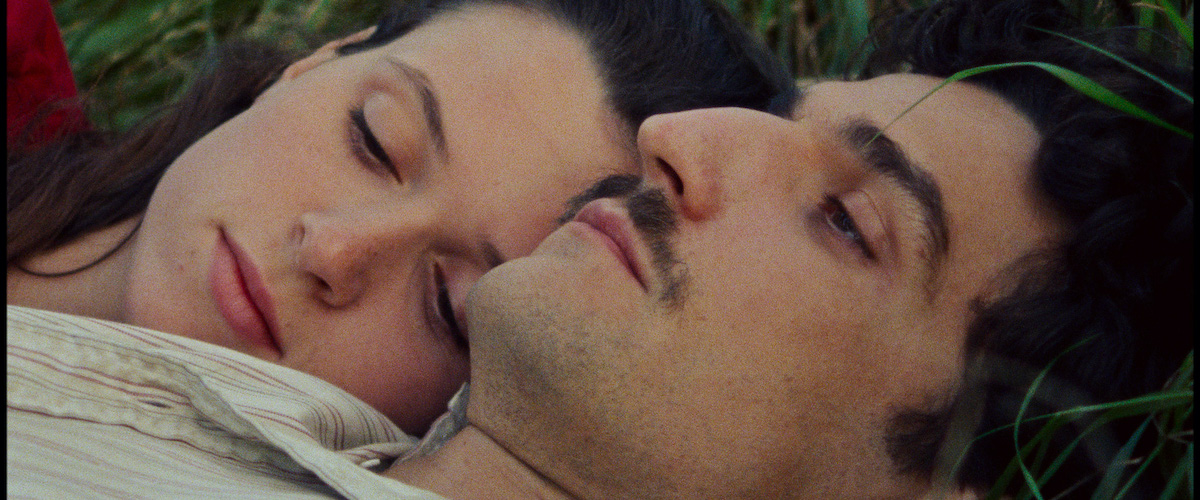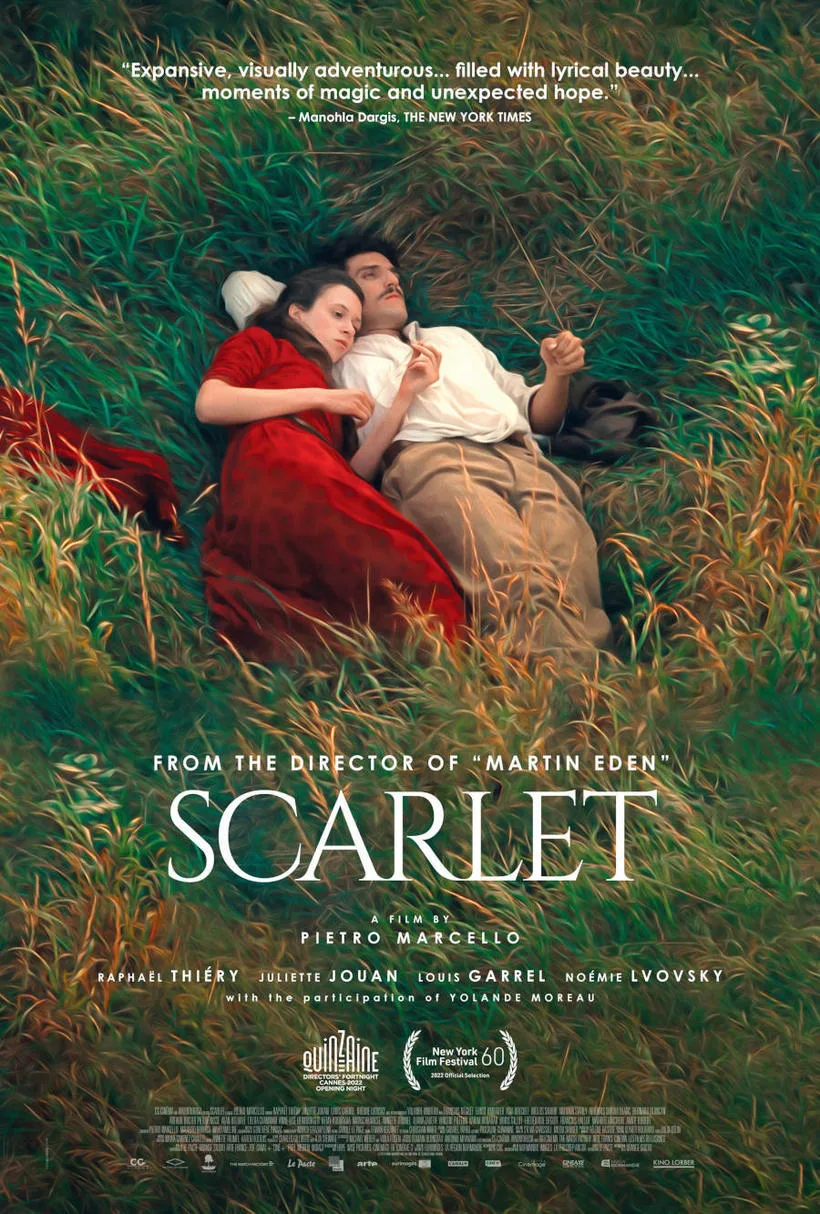A small-town period piece set between World War I and the mid-1930s, “Scarlet” is a French fable by an Italian director. Although its style couldn’t be more different, its conception evokes Wes Anderson’s “The French Dispatch,” which was less a portrait of any era’s “real France” than a world-traveling cinephile’s love letter to French movies and archetypes. “Scarlet” is a bundle of stylistic contradictions, directed by longtime documentary filmmaker Pietro Marcello, whose “Martin Eden” was one of the surprise art house success stories of 2019. With its abundance of natural landscapes and rapturous sunlit-and-candlelit closeups, “Scarlet” feels big even though its scope is constrained (the characters rarely leave their small rural community in Normandy). And although it emphasizes the poverty and harsh physical challenges of the characters’ lives, repeatedly returning to closeups of a manual laborer’s swollen, dirt-caked hands, “Scarlet” also indulges in flights of fancy that have a “what the heck, let’s try it” quality.
Some flights are literal: one of the central characters is a handsome barnstormer who falls in love with our heroine Juliette (Juliette Jouan), a lovely, fierce young woman who grows up under the tutelage of her widowed war veteran-handyman-sculptor father Raphaël (Raphaël Thiéry). She plays piano, has a lovely singing voice, and likes to bathe in the local stream, read poetry and novels under shady trees, and gaze at others with longing, sadness, or resentment. There are also trace elements of ancient fairy tales in the script: the heroine’s guardian (Noémie Lvovsky) tries to teach Juliette magic while lamenting its diminished importance in the era of automobiles, airplanes, and mass-produced machinery. Another recurring character is sort of a Gallic Baba Yaga: an old woman played by Yolande Moreau who lives alone in the woods when she’s not drinking at the local pub, and appears to Juliette at transitional moments in her life, predicting her future, speaking in aphorisms, and smiling sweetly.
Cinematographer Marco Graziaplena’s soft, grainy, 16mm camerawork favors classic handheld “documentary-style” shots, relying on zoom lenses and shake to suggest immediacy. But it’s in service of a lower-budget version of the sorts of epic melodramas that were regularly made in the middle part of the 20th century. There are hexagonal lens flares, lyrical montages, a few straight-out musical numbers with “a cappella” vocals and offscreen piano or orchestra occasionally chiming in as backup, and some of the situations that would’ve fit right into a silent movie about suffering innocents who can’t catch a break. (There are even clips of actual silent films, as well as documentary footage of French life at that time, integrated with the rest of the story.)
The film begins with Raphaël returning home from the war to find that his wife has died in his absence, leaving his infant daughter to be raised by the farm’s owner, her blacksmith, and his wife. Soon after, Raphaël learns that an arrogant businessman in town raped his wife. But although he’s distraught and wants bloody revenge, the situation resolves itself in a surprising way that foreshadows developments in the rest of the film, which is less about the possibility or impossibility of making one’s own way in life than the necessity of finding the strength to accept whatever it throws at you and seek happiness regardless.
The most film’s affecting parts show Raphaël and various younger versions of Juliette developing a rapport that owes more than a bit to almost every cinematic version of “Beauty and the Beast.” But it combines the father-daughter and beauty-beast relationships by bestowing movie-star close-ups on the leading lady while filming Thiéry to emphasize his prominent brow, sunken eyes, broad shoulders, knotty hands, and limping walk. Creativity is the core of their connection. We’d probably instantly buy it even if the film had merely told us about it, thanks to the chemistry between Thiéry and the three actresses who play Juliette at different stages of life.
But Marcello and his four credited screenwriters (who pulled the story from adventure novelist Alexander Grin’s Scarlet Sails) are greatly helped by the fact that the two leads are multi-talented. Thiéry came to acting later in life after a long career as an accomplished professional artist (and amateur musician; he plays accordion and tunes a piano onscreen, and the camera and sound recording make sure you know he can actually do both things). Jouan is a more polished musician who can actually sing and play. Both have been recorded in a way that convinces us that they’re playing or singing, not merely approximating an instrumental performance or lip-synching to a prerecorded track (although Jouan seems to do the latter in a musical number that unfolds as Juliette swims).
Even more impressive are the many scenes where Raphaël fixes things or makes art. The camera gets close to Thiéry’s powerful hands so that we can see that he really could get a job as a carpenter, repair a defective machine part, and carve a ship’s prow from a block of wood with such precision that the visiting barnstormer Jean, a charismatic carouser with an Errol Flynn mustache (soulful hunk Louis Garrel, the exact person you’d want to cast in a part like this), instantly knows it’s modeled on the girl he loved at first sight (and first listen; Jean and Juliette are swimming in different parts of the river when he hears her singing and searches for the source of that voice).
“Scarlet” moves according to its own distinctive rhythm. It’s slower and more contemplative than modern audiences are conditioned to accept, and it frequently surrenders to its muse, like its characters. You’ll settle into a comfortable groove with the film when it’s showing people doing complicated tasks with their bare hands in loving closeup, and then bang, here comes a full-length musical number, an interlude introducing the aviator and his partner in flight, or a scene of potential violence or violation (like her mother, Juliette is targeted with unwanted affection by a local punk who thinks they’re destined to be together and won’t take no for an answer). It’s all over the place, and if there was a way to unify all of its disparate elements, the filmmaker never quite figured it out. You just have to agree that it’s all of a piece and accept it isn’t going to settle into any one mode for very long.
Still, the movie’s stubborn insistence on going where inspiration takes it is fascinating. Fans of European art cinema with a retro flavor will want to check it out just for the combination of Jacques Demy-inspired musical numbers (imagine characters from “The Umbrellas of Cherbourg” transplanted to a farm town); Terrence Malick-inflected shots of grass, trees, sky, water, and animals; and intimate, intense scenes of characters from an earlier time doing what they have to do to survive and be happy.
Now playing in theaters.




















